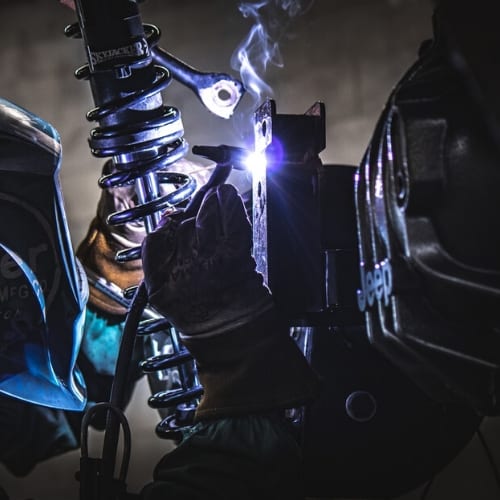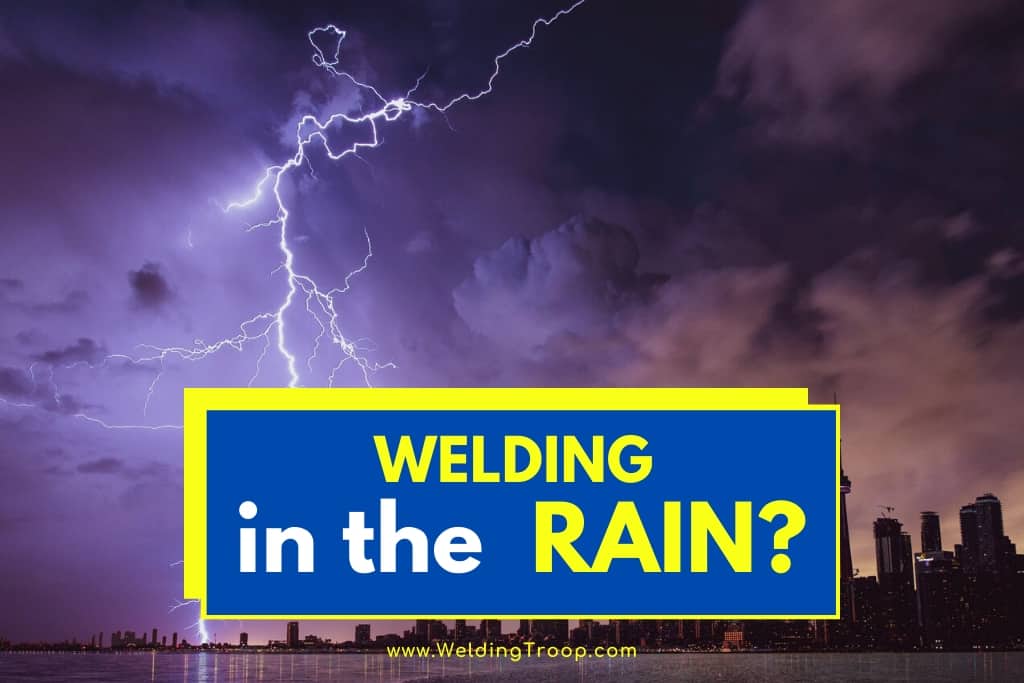Have you ever wondered if you can weld in the rain or when it’s wet? Well, we all know that water and electricity are not best friends. But for welders, sometimes work must be done, even in a state of hazardous weather. Welding requires a multitude of safety precautions on its own, and that is before you add rain, humidity, and lightning into the equation.
Can you MIG weld in the rain? Although there are no legal regulations regarding welding in wet conditions, one must take precautions. With around 30-50 volts of electricity being deadly to humans and MIG welding creating about 15-500 volts, the safety risks and chances of being shocked are high.
Your safety should be the top priority. You may assume that gentle forms of moisture (such as a light shower or even humidity) might be safe; however, this assumption would be wrong. Use this quick read to understand the risks involved, why you must stay dry, and how to protect yourself when you have to MIG weld in the rain!

Table of Contents
Can You MIG Weld in the Rain?
Legally speaking, yes, you can MIG weld in the rain. Despite the safety risks involved, OSHA states:
“The standards that address the use of electrical welding equipment can be found at 29 CFR 1926.351 and 1926.354, as well as 1926.406(c). None of these standards prohibit the use of electrical (arc) welding equipment in inclement (wet) weather.”
Even though welding in the rain is legal, that does not mean it is a good idea. We recommend avoiding welding in the rain altogether, unless absolutely necessary.
Luckily for humans, in dry conditions, the human body does not pick up small currents or voltage of electricity. There is resistance present in the metal material that outweighs the opposition naturally in our bodies, leaving a welder quite safe with gloves and goggles in dry conditions.

Electricity during welding would typically move through the path of:
- Electrode
- The material you are working on
- Earth clamp
However, with rain or moisture involved, you are adding yourself in the middle of this equation, significantly increasing your chances of being shocked.
The Dangers of MIG Welding in Wet Conditions
Electric shock can do the following:
- Damage or ruin the machinery and tools you are working with
- Make it difficult to weld and reach the temperature requirement of that material you are welding
- Decrease your finished product’s quality
- Result in a brittle effect
However, these mean nothing in comparison to your safety. The dangers and risks while you are welding in the rain include but are not limited to:
- Rainwater is a Better Conductor than Filtered Water – Water is not a friend of electricity; we all know this. But rainwater is especially dangerous. Distilled water offers an electrical conduction of zero, while rainwater brings impurities and small organisms that increase the iron content of the water. This can cause a rain-soaked body to become the closing end on a circuit (i.e., electrocution).
- The Risk of Lightning – Where there is rain, there is often thunder and lightning. While the thunder is not inherently dangerous, lightning is. While working with electricity and using metal welding tools, the last interference you want is a strike of electrons discharging across your body. You are holding up a metal rod in a lightning storm, asking to get struck. Don’t do it.
- Wind can Affect Your Lines – With rainy and windy weather, you will not be able to weld safely or accurately. This is not a priority compared to your physical safety.
If you have a pacemaker or any kind of metal plate or pin from past surgeries, you especially should avoid welding in the rain.
Learn More About Personal Protective Equipment – PPE – Here, you can find an article from our website about: Personal Protective Equipment for Welders – PPE | List, and Requirements
How the Voltage Impacts Your Body
Most bodies can withstand a small amount of electricity in the form of a shock, but this is different for each person. Since the pain of an electric shock is quite a subjective sensation, it’s difficult to measure.
As little as 5-volts can stop a heart, so it may take extraordinarily low voltage to make welding in wet conditions hazardous. Considering most welds require 20-50-volts, (upwards of 100-500-volts for larger-scale requirements), your body is simply not strong enough to withstand multiple high-current shocks.
Voltage reacts with each person differently. While one person may have been shocked hundreds of times while working on electrical currents for the past two decades, another person could die from their first shock. It is nearly impossible to predict how your body will react to that amount of conduction, but the wrong amount at the wrong time will be life-threatening.
Many welders and electricians point out that the more often you work, the more you risk yourself and increase the chances of eventually being shocked. So, why increase your risks even more by doing it in a rainstorm?
When You Should Avoid Welding
You may think that rainstorms are the only welding fear you need to have when it comes to water. However, there is more to fear than just a drizzle. It is not only direct rain contact but rather any form of moisture that can increase your risks of being shocked.
If you are:
- Standing in a puddle of water
- Working without gloves
- Working with wet hands
- Working with sweaty hands
- Working in intensely humid conditions
Then the electric current may attempt or succeed in completing itself through your body, causing an electrical shock.
This is Kirchhoff’s Law of Physics and Circuit Theory, which explains how charge conversions will seek out the most straightforward path to complete the circuit. Like a chain finishing the link, the circuit will end through you – causing a tingling sensation, typically down your body and towards the ground. Depending on the voltage, this could be fatal and immediately stop your heart.
Related Article: 7 Steps for Avoiding Electric Shock When Welding Underwater
If You Must MIG Weld in the Rain
Sometimes duty calls, and there is nothing to be done about it.
Although we do not recommend welding in the rain, if you must – here are the tips for doing so safely:
| Steps | To Do´s |
| 1 | Move the job Indoors |
| 2 | Provide Shelter for yourself |
| 3 | Do NOT stand in puddles |
| 4 | If working in the mud |
| 5 | Keep your gear dry |
| 6 | Keep everything dry |
- Move the Job Indoors – If at all possible, this will be the ideal course of action.
- Provide Shelter for Yourself – You will need some coverage or shelter overhead while working with a MIG or welding machine. You can use things such as:
- A metal roof
- A tent (with high ceilings)
- Anything without a leak
- Do NOT Stand in Puddles – This is deadly. Standing directly in water will tell the current to move towards your body into the iron-rich rainwater. This is the only thing worse than using wet hands directly on your project. Always work on a dry surface and wear the proper gear.
- If Working in the Mud – Use a piece of plywood or any material that is not an electrical conductor. Stand on something to raise your elevation and remove yourself from the wet mud.
- Keep Your Gear Dry At All Times – This includes rainwater and even the sweat on your gloves. You should wear gloves, aprons, and boots only made of leather or rubber as these materials are wonderful insulators. However, if they get wet, they will still be dangerous, so do not rely on their robust insulation alone.
- Keep Everything Dry – This includes:
- Your body
- Your working surface
- The ground you are on (or raise your elevation)
- The machine you are using
- The clothes you are wearing
- Everything!
- If your machine reacts to the weather, turn it off immediately.
- If moisture encounters anything, wipe it down immediately and keep a dry towel nearby.
- If that becomes too drenched, have back-up towels that are 100% dry.
Final Verdict
Postpone the job.
If your employer wants you to risk your life, say no. If they are forcing you to do so, they do not care about your safety or wellbeing. You can find another job, but you cannot find another life.
Recommended Reading
Is Welding a Hard Job? | All Facts You Need To Know
7 Steps for Avoiding Electric Shock When Welding Underwater
How Much do MIG Welders Make? Average MIG Welder Salary
Welding and Wet Welding Gloves >> Video
Here are some of my favorite tools & equipment´s
Thank you for reading this article. I hope it helps you find the most recent and accurate information for your welding project. Here are some tools that I use daily and hope you´ll also find helpful.
There are affiliate links, so if you do decide to use any of them, I´ll earn a small commission. But in all honesty, these are the exact tools that I use and recommend to everyone, even my own family. (NO CRAP)
To see all my of most up-to-date recommendations, check out this resource that I made for you!


